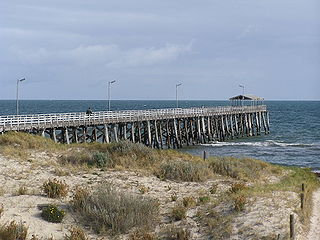
Port Augusta is a small city in South Australia. Formerly a seaport, it is now a road traffic and railway junction city mainly located on the east coast of the Spencer Gulf immediately south of the gulf's head and about 322 kilometres (200 mi) north of the state capital, Adelaide. The suburb of Port Augusta West is located on the west side of the gulf on the Eyre Peninsula. Other major industries included, up until the mid-2010s, electricity generation. At June 2018, the estimated urban population was 13,799, having declined at an average annual rate of -0.53% over the preceding five years.

Grange is a coastal suburb of the City of Charles Sturt, in Adelaide, South Australia, located about 11 kilometres (6.8 mi) from the Adelaide city centre. The suburb is named after Captain Charles Sturt's cottage, built in 1840–41, which still stands and is now a museum. In addition to Grange Beach, the suburb has several parks and reserves, as well as the Grange Hotel, which was originally licensed in 1881.

Kilburn is a suburb in the inner north of Adelaide, South Australia. The suburb borders Blair Athol, Gepps Cross, Wingfield, Regency Park and Prospect. Kilburn has the same postcode (5084) as Blair Athol and was previously known as 'Little Chicago' before its name was changed during the 20th century.

Torrensville is a western suburb 3 km (1.9 mi) west of the centre of Adelaide, South Australia. It was named after Irish-born economist and chairman of the South Australian Colonisation Commission, Robert Torrens.

The Grange railway line is a suburban branch line in Adelaide, South Australia.

Thebarton, formerly Theberton, on Kaurna land, is an inner-western suburb of Adelaide, South Australia in the City of West Torrens. The suburb is bounded by the River Torrens to the north, Port Road and Bonython Park to the east, Kintore Street to the south, and South Road to the west.
Outer Harbor is a suburb in the Australian state of South Australia located at the northern tip of the Lefevre Peninsula about 22 kilometres (14 mi) north-west of the Adelaide city centre.

Semaphore is a northwestern suburb of Adelaide in the Australian state of South Australia. It is located on the Gulf St Vincent coastline of the Lefevre Peninsula about 14 kilometres (8.7 mi) from the Adelaide city centre.

Largs Bay is a suburb in the Australian state of South Australia located on the Lefevre Peninsula in the west of Adelaide about 16 kilometres (9.9 mi) northwest of the Adelaide city centre.

Exeter is a north-western suburb of Adelaide 14 km from the CBD, on the LeFevre Peninsula, in the state of South Australia, Australia and falls under the City of Port Adelaide Enfield. It is adjacent to Semaphore, Birkenhead, Largs Bay and Glanville. It is bounded to the south by Exmouth Road, to the north by Hargrave Street and in the east and west by the Outer Harbor railway line and Woolnough Road respectively.

The City of West Torrens is a local government area in the western suburbs of Adelaide, South Australia. Since the 1970s the area was mainly home to many open spaces and parks, however after the mid-1990s (1993-1995) the LGA became more residential.

Brompton is an inner-northern suburb of Adelaide, South Australia in the City of Charles Sturt.

The Thebarton Theatre, also known as the Thebbie Theatre or simply Thebbie/Thebby, is an entertainment venue located in the inner-western Adelaide suburb of Torrensville, South Australia. Built in 1926 as a combined town hall / picture theatre and officially known as Thebarton Town Hall and Municipal Offices, the building was opened in June 1928. It was listed on the South Australian Heritage Register on 23 September 1982.

Port Road is a major road in Adelaide, South Australia connecting the Adelaide city centre with Port Adelaide. It is 12 km (7.5 mi) long, and is designated part of route R1 within central Adelaide, and beyond as route A7.

Fulham is a western suburb of Adelaide, South Australia. It is located in the City of West Torrens.

The South Australian Brewing Company, Limited is a brewery located in Thebarton, an inner-west suburb of Adelaide, South Australia. It is a subsidiary of Lion, which in turn is owned by Kirin, a Japan-based beverage company. It manufactures West End Draught beer.

Henley Beach South is a coastal suburb of Adelaide, South Australia. It is located in the City of Charles Sturt.
The Holdfast Bay railway line was a railway in western Adelaide. The line started in the city from the Adelaide railway station, and then headed west. From approximately where Henley Beach Road currently is, the railway then followed an almost direct route to the seaside suburb of Glenelg.

Richmond is an inner suburb of Adelaide, South Australia. It is located on Kaurna land in the City of West Torrens.

The Town of Thebarton was a local government area of South Australia from 1883 until 1997. It was seated at the village of Thebarton, now an inner west suburb of Adelaide.
























